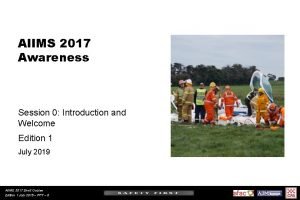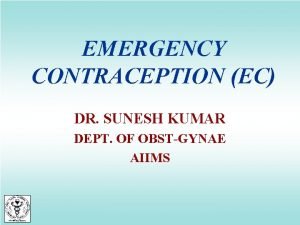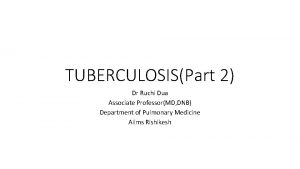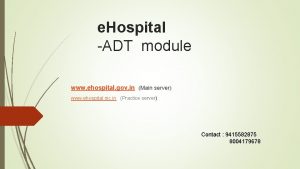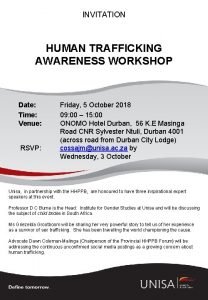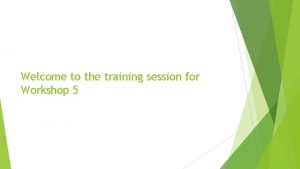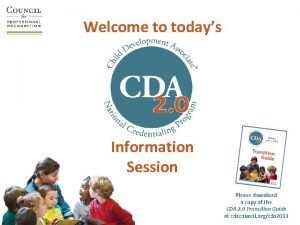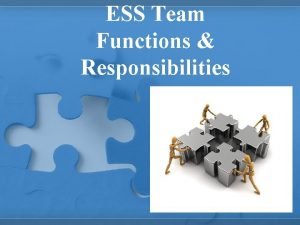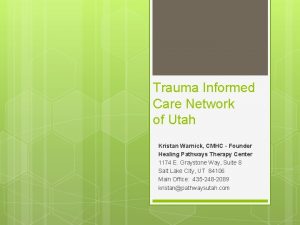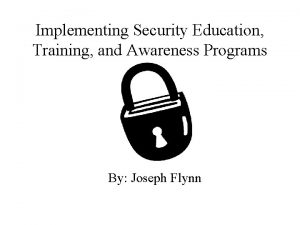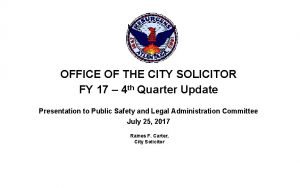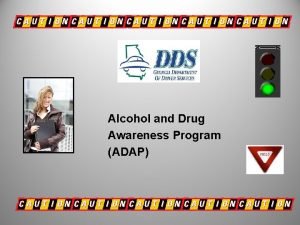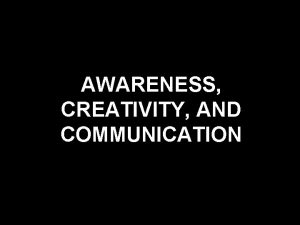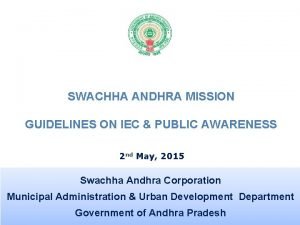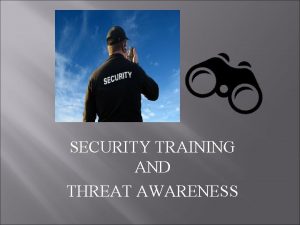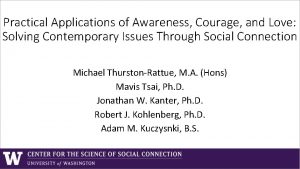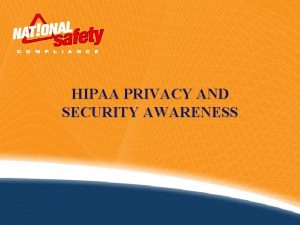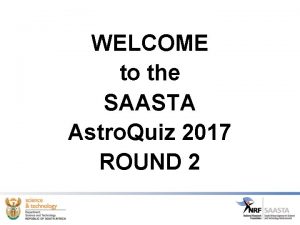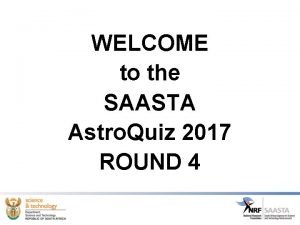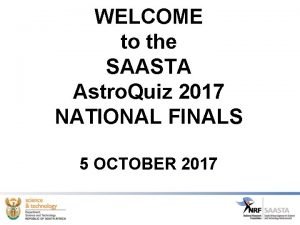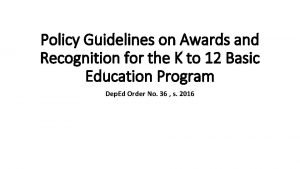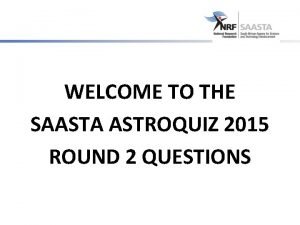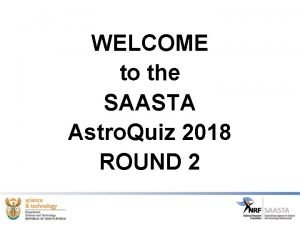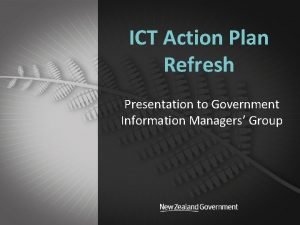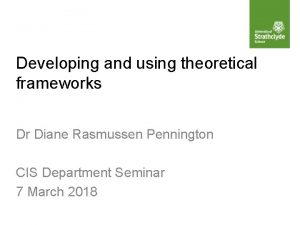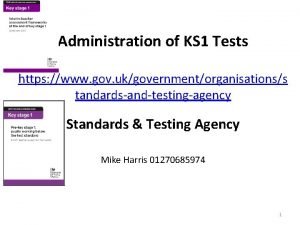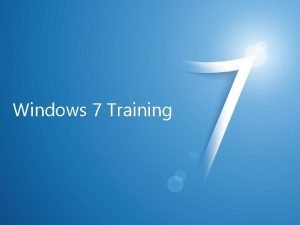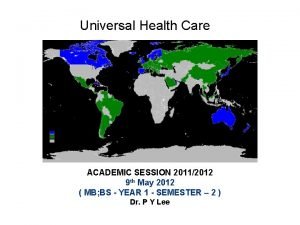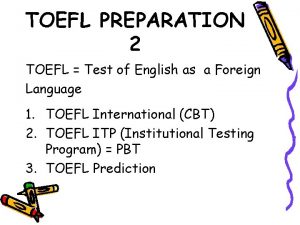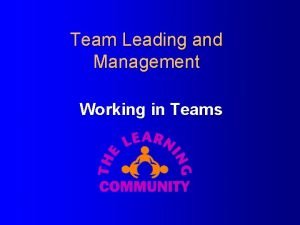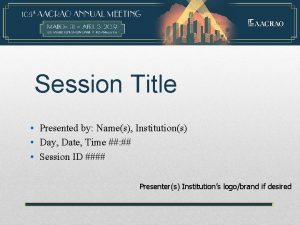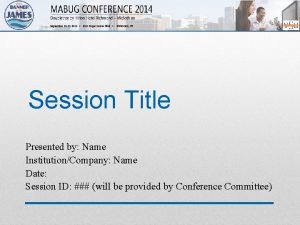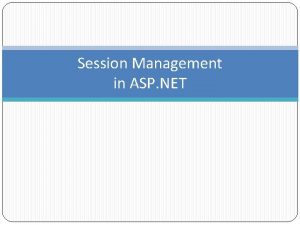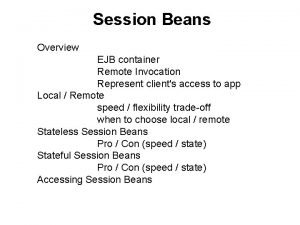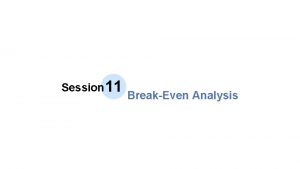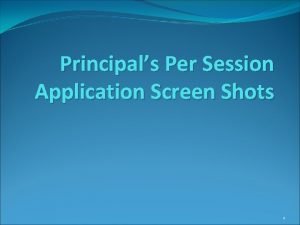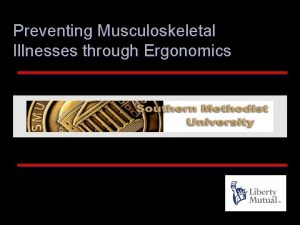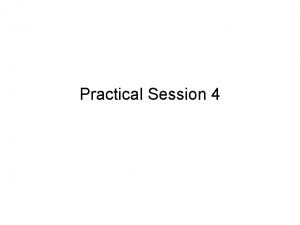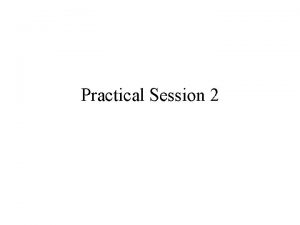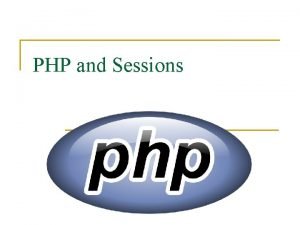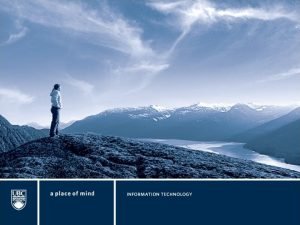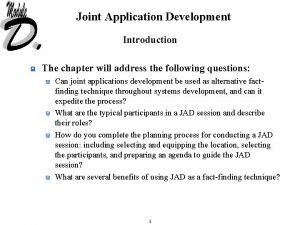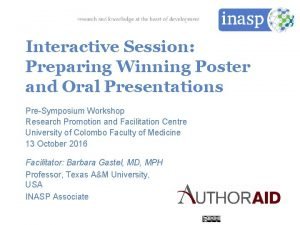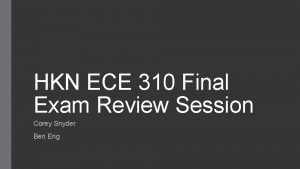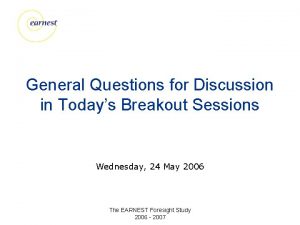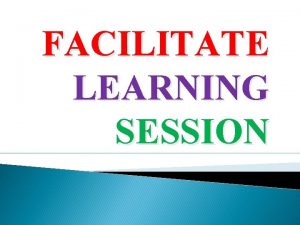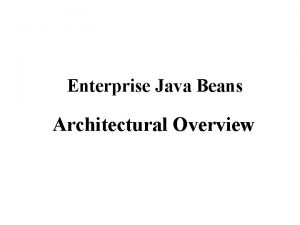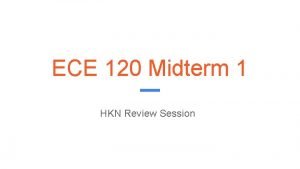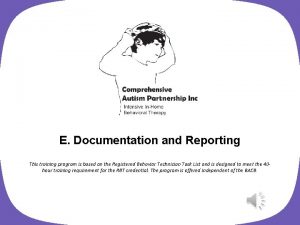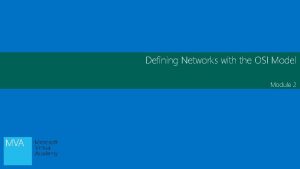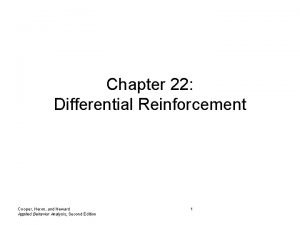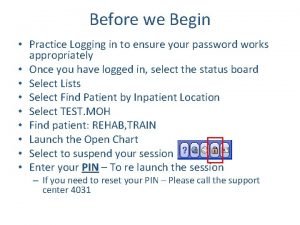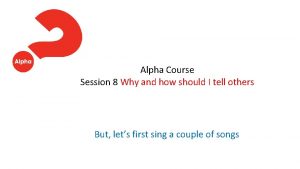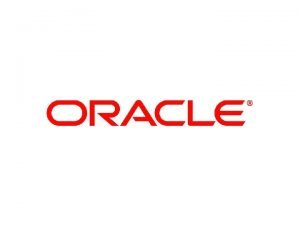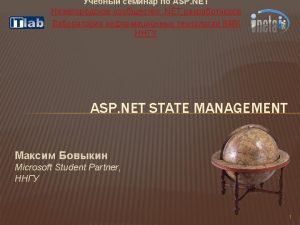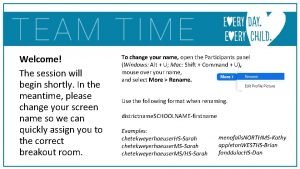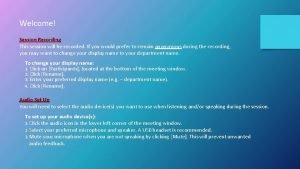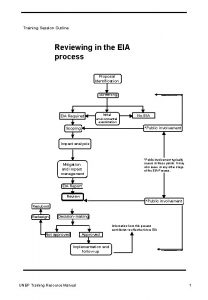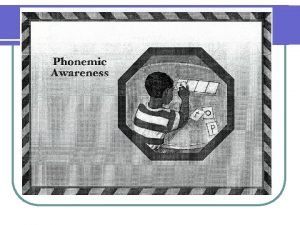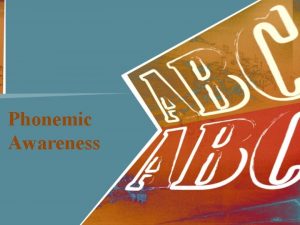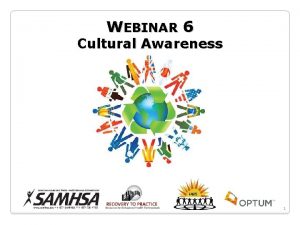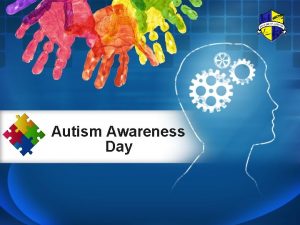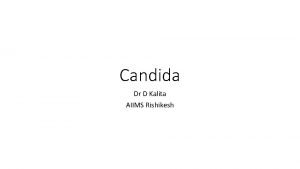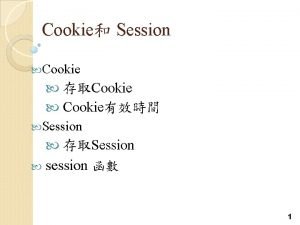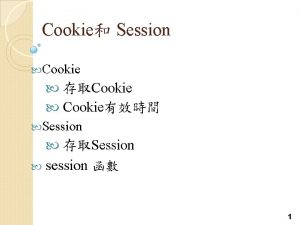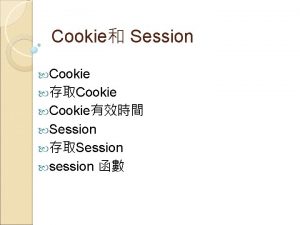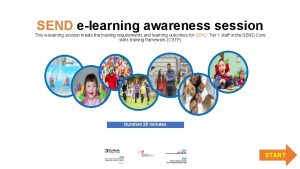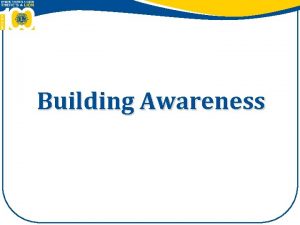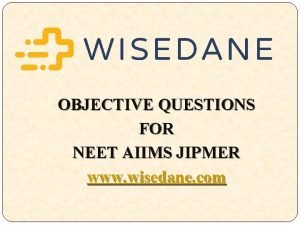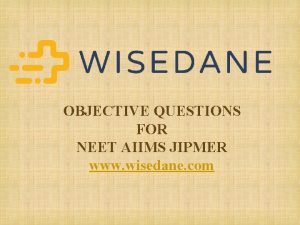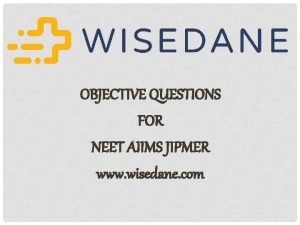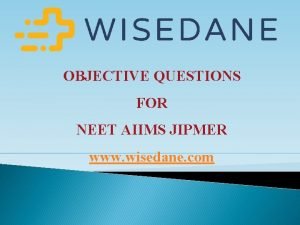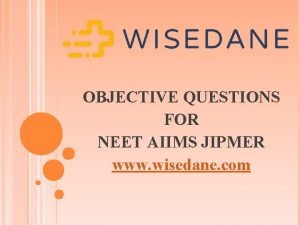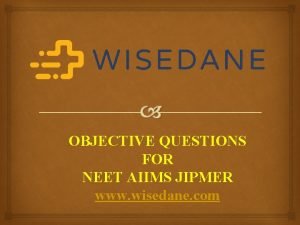AIIMS 2017 Awareness Session 0 Introduction and Welcome




















































































- Slides: 84

AIIMS 2017 Awareness Session 0: Introduction and Welcome Edition 1 July 2019 AIIMS 2017 Short Course Edition 1 July 2019 – PPT – 0

What do you know about these topics? AIIMS principles. Command, Control and Coordination. Common Operating Picture. The functional areas: • • Incident control Planning Intelligence Public Information Operations Investigation Logistics Finance AIIMS 2017 Short Course Edition 1 July 2019 – PPT – 1

The course consists of four sessions What is AIIMS? AIIMS principles and underlying concepts Incidents and incident management Incident action planning AIIMS 2017 Short Course Edition 1 July 2019 – PPT – 2

The goal of this program is To provide you with an overview of the Australasian Inter-service Incident Management System (AIIMS) framework. AIIMS 2017 Short Course Edition 1 July 2019 – PPT – 3

The assessment requires you to Attend all sessions. Lead and participate actively in group discussions and presentations during the training. Complete the written assessments consisting of: • multiple choice questions • case-study/scenario AIIMS 2017 Short Course Edition 1 July 2019 – PPT – 4

AIIMS 2017 Awareness Session 1: What is AIIMS? AIIMS 2017 Short Course Edition 1 July 2019 – PPT – 5

This session will cover the following topics Enables and blockers – an activity Introduction to AIIMS More about AIIMS 2017 Short Course Edition 1 July 2019 – PPT – 6

This session will cover the following topics Working with others – an activity The AIIMS 2017 manual AIIMS 2017 Short Course Edition 1 July 2019 – PPT – 7

At the end of this session you will be able to do the following Explain what AIIMS is. Provide examples of situations in which AIIMS can be used. Describe how AIIMS helps in the effective management of incidents. AIIMS 2017 Short Course Edition 1 July 2019 – PPT – 8

Enablers and blockers – a 10 minute activity Identify factors that make working together easier and contributed to achieving results. Identify factors that hinders working together and caused activities not to progress, or produce unsatisfactory results. AIIMS 2017 Short Course Edition 1 July 2019 – PPT – 9

What is AIIMS is a system for the management of all incidents. Incidents can be imminent or actual, occurring in the natural or built environment. AIIMS can be used for many other activities that emergency management organisations, and those that support them, have to deal with. AIIMS 2017 Short Course Edition 1 July 2019 – PPT – 10

What is an incident? AIIMS defines the incident as an event, occurrence or set of circumstances that: • has a definite spatial extent; • has a definite duration; • calls for human intervention; • has a set of concluding conditions that can be defined; • is or will be under the control of an individual who has the authority to make decisions about the means by which it will be brought to a resolution. AIIMS 2017 Short Course Edition 1 July 2019 – PPT – 11

Incident management is defined as… Those processes, decisions, and actions taken to resolve and emergency incident and to support recovery, thereby enabling the community to return to normality. AIIMS 2017 Short Course Edition 1 July 2019 – PPT – 12

More about AIIMS provides a common incident management system for all responding agencies and personnel. AIIMS integrates the activities and resources for the effective and safe resolution of any incident. AIIMS 2017 Short Course Edition 1 July 2019 – PPT – 13

More about AIIMS The system and the principles on which AIIMS is based can also be applied to any non-emergency response situations, such as major sporting and cultural events, exhibitions and conferences. AIIMS 2017 Short Course Edition 1 July 2019 – PPT – 14

Benefits of an incident management system Minimises the impact on the community and environment Facilitates an effective and efficiently controlled response to an incident Provides a safe working environment for all responders. AIIMS 2017 Short Course Edition 1 July 2019 – PPT – 15

About the AIIMS Manual For personnel who will be applying AIIMS to incidents and those who will be supervising and preparing personnel for the task. Supported by procedural and technical doctrine of the organisations that use AIIMS. Developed in accordance with the Fundamentals of Doctrine: Best Practice Creation, V. 2 (AFAC, 2016). AIIMS 2017 Short Course Edition 1 July 2019 – PPT – 16

Part 1 of the AIIMS 2017 manual covers incident management Introduction AIIMS in emergency management Building an incident management structure Incident action planning AIIMS principles and underpinning concepts Risk management Regional and state arrangements Information flow Incident classification Managing the incident AIIMS 2017 Short Course Edition 1 July 2019 – PPT – 17 Relief and recovery Incident management team member skills

Part 2 of the AIIMS 2017 manual covers the functions of incident management Incident control Planning Intelligence Public information Operations Investigation Logistics Finance AIIMS 2017 Short Course Edition 1 July 2019 – PPT – 18

Doctrine Layer Description Capstone Single publication specifying an organisation’s legitimacy, ethos and core functions, e. g. vision, mission, values Fundamentals Principles-based detail about an organisation’s major function, e. g. AIIMS Manual is principles-based doctrine for organisations that have an emergency management function Procedural Detailed description for executing tasks and actions, e. g. SOPs and SOGs Technical Application of knowledge for discrete actions or tasks, e. g. operating instructions, AIIMS Aides-mémoire & checklists AIIMS 2017 Short Course Edition 1 July 2019 – PPT – 19

Managing incidents effectively requires the following Everyone working towards a common objective. Good communication flows. Good teamwork in multi-agency teams. Learning from past events through debriefs and shared information. Clearly defined roles. Established arrangements for organisations to work together. AIIMS 2017 Short Course Edition 1 July 2019 – PPT – 20

Managing incidents effectively requires the following A consistent approach. A common language, minimising confusion about terms used. A single point of contact or coordination. Frequent evaluation of activities, to enable revision of planning. Interchangeable equipment and consistent pre-planning. Proper briefing of personnel. AIIMS 2017 Short Course Edition 1 July 2019 – PPT – 21

AIIMS in emergency management ‘Comprehensive’ and ‘integrated’ approach to emergency management. ‘All hazards–all agencies’ model of emergency management. Whole of government approach. It is essential that government agencies communicate, work together, and plan collaboratively with communities. AIIMS 2017 Short Course Edition 1 July 2019 – PPT – 22

AIIMS in emergency management AIIMS 2017 Short Course Edition 1 July 2019 – PPT – 23

In summary, AIIMS is an emergency management system that provides A comprehensive and integrated response to any type of emergency An “all hazards-all agencies” model A “whole of government” approach. Questions? AIIMS 2017 Short Course Edition 1 July 2019 – PPT – 24

AIIMS 2017 Awareness Session 2: AIIMS Principles and underpinning concepts AIIMS 2017 Short Course Edition 1 July 2019 – PPT – 25

This session will cover these topics AIIMS principles The five principles of AIIMS Underpinning concepts Terminology AIIMS 2017 Short Course Edition 1 July 2019 – PPT – 26

At the end of this session you will be able to Explain the principles of AIIMS. Demonstrate an understanding of the underpinning concepts that support each principle. Differentiate between the terms Control, Command Coordination. AIIMS 2017 Short Course Edition 1 July 2019 – PPT – 27

AIIMS is based on five principles Unity of command Span of control Functional management Management by objectives Flexibility AIIMS 2017 Short Course Edition 1 July 2019 – PPT – 28

Unity of command Each individual should report to only one Supervisor. There is only one Incident Controller (IC). There is one set of common objectives for all those responding to an incident, leading to one consolidated plan for all responders. AIIMS 2017 Short Course Edition 1 July 2019 – PPT – 29

Span of control refers to the number of groups or individuals that can be successfully supervised by one person. Supervisor AIIMS 2017 Short Course Edition 1 July 2019 – PPT – 30

AIIMS define a function as follows An activity or grouping of activities addressing core responsibilities of the Incident Controller. There are many different combinations of tasks that could be grouped together as ‘functions’. AIIMS identifies eight groupings as the most useful for managing incidents. AIIMS 2017 Short Course Edition 1 July 2019 – PPT – 31

Functional management within AIIMS Within AIIMS, the functions are performed and managed by the Incident Controller. When required, the Incident Controller can delegate one or more of the functions. However, at all times, the Incident Controller still remains accountable. AIIMS 2017 Short Course Edition 1 July 2019 – PPT – 32

About each function Function Responsibility Control Management of all activities necessary for resolution of the incident. Planning The development of objectives, strategies and plans for the resolution of an incident, based on the outcomes of collection and analysis of information. Intelligence The task of collecting and analysing information or data, which are recorded and disseminated as intelligence to support decision making and planning. Public information Provision of warnings, information and advice to the public, and liaison with the media and affected communities. AIIMS 2017 Short Course Edition 1 July 2019 – PPT – 33

About each function Function Responsibility Operations Tasking and application of resources to achieve resolution of the incident. Investigation Conducting investigations to determine the cause of an incident and/or factors that contributed to the impact of the incident or specific events Logistics Acquisition and provision of human and physical resources, facilities, services and materials to support achievement of the incident objectives. Finance Managing: • • • AIIMS 2017 Short Course Edition 1 July 2019 – PPT – 34 accounts for purchases of supplies and hire of equipment insurance and compensation for personnel, property and vehicles collection of cost data & provision of cost-effective analyses and providing cost estimates for the incident.

Establishing sections The prompts for establishing sections may include: • the functional officer is becoming overwhelmed with their existing responsibilities • information flow to the Incident Management Team, relating to the tasks of that function, is inadequate, and a direct report to the Incident Controller is desirable • the function requirements to the incident are known to be so complex that a section is required to deal with them. AIIMS 2017 Short Course Edition 1 July 2019 – PPT – 35

Safety is more than a function – it is an inherent task of all functions. AIIMS 2017 Short Course Edition 1 July 2019 – PPT – 36

Management by objectives The Incident Controller communicates agreed incident objectives* to everyone involved in the incident. All incident personnel work towards these objectives. The Incident Action Plan outlines the current plan for achieving these objectives. *Incident objectives should capture the Incident Controller’s Intent. AIIMS 2017 Short Course Edition 1 July 2019 – PPT – 37 Why a task is to Purpose be done Task End state What is to be done Outcome of task when successfully completed.

Flexibility A flexible approach to the application of AIIMS is essential. The system can be applied across the full spectrum of incidents. Any rigid application of the structures and processes may compromise the effectiveness of the response. AIIMS 2017 Short Course Edition 1 July 2019 – PPT – 38

Underpinning concepts AIIMS 2017 Short Course Edition 1 July 2019 – PPT – 39

Command, control and coordination AIIMS 2017 Short Course Edition 1 July 2019 – PPT – 40

Command, control and coordination Command The internal direction of the members and resources of an organisation Control The overall direction of emergency management activities across organisations Coordination Delivering support to the incident AIIMS 2017 Short Course Edition 1 July 2019 – PPT – 41

In summary, AIIMS is based on principles and concepts AIIMS is based on five principles • Unity of command • Span of control • Functional management • Management by objectives • Felicity AIIMS has defined underpinning concepts Questions? AIIMS 2017 Short Course Edition 1 July 2019 – PPT – 42

AIIMS 2017 Awareness Session 3: Incidents and incident management AIIMS 2017 Short Course Edition 1 July 2019 – PPT – 43

This session will cover these topics Incident classification Managing an incident Building incident management structures Delegation and Deputy Incident Controllers AIIMS 2017 Short Course Edition 1 July 2019 – PPT – 44

At the end of this session you will be able to Outline the different ways that incidents can be classified. Explain the role of an Incident Management Team (IMT). Outline the tasks undertaken by the IMT. AIIMS 2017 Short Course Edition 1 July 2019 – PPT – 45

Incidents are classified in three levels Level 1 incidents are characterised by being able to be resolved through the use of local or initial response resources only. AIIMS 2017 Short Course Edition 1 July 2019 – PPT – 46

Incidents are classified in three levels Level 2 incidents are more complex in either size, resources or risks. AIIMS 2017 Short Course Edition 1 July 2019 – PPT – 47

Incidents are classified in three levels Level 3 incidents: • are characterised by degrees of complexity that may require the establishment of divisions for effective management of the situation • will usually involve delegation of all functions. AIIMS 2017 Short Course Edition 1 July 2019 – PPT – 48

Managing an incident Incident management is defined as: ‘ …those processes, decisions and actions taken to resolve an emergency incident and to support recovery that will enable the community to return to normality. ’ AIIMS 2017 Short Course Edition 1 July 2019 – PPT – 49

Functions of incident management Control Planning Intelligence Public Information Operations Investigation Logistics Finance AIIMS 2017 Short Course Edition 1 July 2019 – PPT – 50 Intelligence, Investigation and Finance will only be established as functional sections where the Incident Controller believes this is necessary and appropriate for the effective management of the incident.

Building an Incident Management Team By delegating some or all of the functions, the Incident Controller builds a team to assist in managing the incident response. The Incident Management Team (IMT) is a critical concept in AIIMS 2017 Short Course Edition 1 July 2019 – PPT – 51

The role of the Incident Management Team The IMT helps to ensure that control of the incident: • is properly planned • is adequately resourced • is suitably implemented • provides for safety and welfare • informs and assists affected communities • minimises impacts on infrastructure and the environment • is effective and efficient. AIIMS 2017 Short Course Edition 1 July 2019 – PPT – 52

IMT tasks Build a picture of what has happened, what is happening, and what is likely to happen. Decide what needs to be done and how it will be done. Prepare a plan that captures those decisions. Gather the resources necessary. Implement the plan and monitor its progress. AIIMS 2017 Short Course Edition 1 July 2019 – PPT – 53

IMT tasks Keep people and organisations informed of all these actions. Maintain records of their deliberations and decisions. Manage environmental impacts and consequences of the response effort. Initiate and support relief and recovery efforts for affected communities. AIIMS 2017 Short Course Edition 1 July 2019 – PPT – 54

Common Operating Picture The Common Operating Picture (COP) is a product put together to promote shared and consistent situational awareness about the incident for the IMT and other stakeholders. The COP enables members to work together in a coordinated manner towards common objectives. AIIMS 2017 Short Course Edition 1 July 2019 – PPT – 55

Common Operating Picture The diagram below conceptualises the relationship between COP and team and member situational awareness. • Each circle indicates a team member’s situational awareness. • The shaded central core shows shared situational awareness built around the COP. • The unshaded areas indicate the situational awareness held by team members that is related to their role. AIIMS 2017 Short Course Edition 1 July 2019 – PPT – 56

Example of a Level 1 incident management structure AIIMS 2017 Short Course Edition 1 July 2019 – PPT – 57

Example of a Level 2 incident management structure AIIMS 2017 Short Course Edition 1 July 2019 – PPT – 58

Example of a Level 3 incident management structure AIIMS 2017 Short Course Edition 1 July 2019 – PPT – 59

Example of a Level 3 incident management structure AIIMS 2017 Short Course Edition 1 July 2019 – PPT – 60

Deputy Incident Controllers Supervision of some personnel within the incident management structure (but not those already allocated into a functional section) Building and maintaining relationships with support organisations and other affected interested parties Providing relief for the Incident Controller when the Incident Controller needs to be absent from the Incident Control Centre Acting as a spokesperson for the Incident Controller. AIIMS 2017 Short Course Edition 1 July 2019 – PPT – 61

Control facilities Field location known as an Incident Control Point, often supported by purpose built vehicles deployed for that purpose. For larger scale or more complex incidents an established facility known as an Incident Control Centre will be used. Other facilities may be established based on the size and complexity of the incident. AIIMS 2017 Short Course Edition 1 July 2019 – PPT – 62

In summary, incidents and incident management have these characteristics Incidents are classified in three levels, indicating their complexity. The Incident Management Team is responsible for the resolution of the incident. A common operating picture promotes shared and consistent situational awareness. Questions? AIIMS 2017 Short Course Edition 1 July 2019 – PPT – 63

AIIMS 2017 Awareness Session 4: Incident Action Planning AIIMS 2017 Short Course Edition 1 July 2019 – PPT – 64

This session will cover the following topics Incident Action Planning (IAP) What should an IAP include and the key features of the plan Objectives, strategies and tactics The planning meeting AIIMS 2017 Short Course Edition 1 July 2019 – PPT – 65

This session will cover the following topics Communicating the plan Complementary plans Planning cycle Risk management AIIMS 2017 Short Course Edition 1 July 2019 – PPT – 66

At the end of this session you will be able to do the following Identify the purpose of an Incident Action Plan (IAP). Describe the key features of an IAP. Identify the factors to be considered in the development of an IAP. Explain how to conduct a dynamic risk assessment. AIIMS 2017 Short Course Edition 1 July 2019 – PPT – 67

What is an Incident Action Plan? An IAP is used to: • specify the overall incident objectives and strategies • identify the key threats and risk exposures • ensure the continuity of command control • ensure effective use of resources • identify anticipated resources needed. The incident objectives within the IAP should be a clear statement of the Incident Controller’s Intent. AIIMS 2017 Short Course Edition 1 July 2019 – PPT – 68

What should an IAP include? What we face and what we’re doing • Current situation and predictions of likely development • Key risk exposures • Incident objectives • Recommended strategies and alternate strategies • Maps and/or site plans of the incident location, showing Divisions, Sectors and the area affected. AIIMS 2017 Short Course Edition 1 July 2019 – PPT – 69

What should an IAP include? Keeping people safe. • Risks to health and safety of responders and actions to mitigate those risks • Medical Plan and consideration of occupational health and safety issues • Accommodation and welfare arrangements • Traffic Management Plan, if required, showing direction of travel around the incident. AIIMS 2017 Short Course Edition 1 July 2019 – PPT – 70

What should an IAP include? Keeping people informed … • Communications Plan, including information on all organisations involved and appropriate contact details. • Information Plan for managing enquiries from, and dissemination of information to, external parties. AIIMS 2017 Short Course Edition 1 July 2019 – PPT – 71

Features of an effective IAP AIIMS 2017 Short Course Edition 1 July 2019 – PPT – 72 Accurate Timely Relevant and Concise Complete

Incident objectives An objective (or set of objectives) is critical for the effective management of an incident. The objectives should clearly communicate the outcome to be achieved to all those involved. A well-worded objective has meaning and provides direction for every person at an incident. AIIMS 2017 Short Course Edition 1 July 2019 – PPT – 73 Purpose Task End state Why a task is to be done What is to be done Outcome of task successfully completed.

Effective objectives in AIIMS will include these elements An intent (what) A time parameter (when) A space parameter (where) AIIMS 2017 Short Course Edition 1 July 2019 – PPT – 74

SMART objectives Specific Measurable Achievable Relevant Time framed AIIMS 2017 Short Course Edition 1 July 2019 – PPT – 75

SMART objective examples For an IT Help Desk: By June 2014, the IT Help Desk will respond to all Help requests within 24 hours of receiving a call. For Australia Post: By December 2018, Australia Post will deliver all mail items posted anywhere in Australia to other parts of Australia by 7 business days. AIIMS 2017 Short Course Edition 1 July 2019 – PPT – 76

Strategy A strategy outlines the approach to be taken in working towards achievement of an objective. AIIMS 2017 Short Course Edition 1 July 2019 – PPT – 77

Tactics are the detailed activities describing how a strategy will be achieved. AIIMS 2017 Short Course Edition 1 July 2019 – PPT – 78

Complementary plans Evacuation Plans AIIMS 2017 Short Course Edition 1 July 2019 – PPT – 79 Traffic Plans Change over Plans Demobilisation plans

The planning cycle AIIMS 2017 Short Course Edition 1 July 2019 – PPT – 80

Dynamic risk assessment process AIIMS 2017 Short Course Edition 1 July 2019 – PPT – 81

Dynamic risk assessment process AIIMS 2017 Short Course Edition 1 July 2019 – PPT – 82

In summary, Incident Action Planning is a process central to AIIMS An IAP provides relevant information to everyone managing the incident and communicates the SMART incident objectives. Risk is managed and reduced by using the incident management structure and the decision-making and planning processes. Questions? AIIMS 2017 Short Course Edition 1 July 2019 – PPT – 83
 Aiims 2017 manual download
Aiims 2017 manual download Dr neena khanna aiims
Dr neena khanna aiims Sunesh kumar
Sunesh kumar Dr ruchi dua
Dr ruchi dua Ehospital aiims
Ehospital aiims Privacy awareness and hipaa awareness training cvs
Privacy awareness and hipaa awareness training cvs Date time venue invitation
Date time venue invitation Welcome to new session 2020-21
Welcome to new session 2020-21 Welcome to the training session
Welcome to the training session Welcome to today's session
Welcome to today's session Welcome session agenda
Welcome session agenda Welcome to today's session
Welcome to today's session Welcome welcome this is our christmas story
Welcome welcome this is our christmas story Introduction to mental health awareness presentation
Introduction to mental health awareness presentation Environmental awareness introduction
Environmental awareness introduction Welcoming prayer sample
Welcoming prayer sample Trauma awareness and treatment center utah
Trauma awareness and treatment center utah Positive physical approach
Positive physical approach Security education training and awareness seta program
Security education training and awareness seta program Awareness of ourselves and our environment is:
Awareness of ourselves and our environment is: Your conscious awareness of your own name
Your conscious awareness of your own name Ptit safe driving and awareness course online
Ptit safe driving and awareness course online Childhood sensuality circle
Childhood sensuality circle Our awareness of ourselves and our environment.
Our awareness of ourselves and our environment. Tadra is an acronym for georgia’s
Tadra is an acronym for georgia’s When a driver's awareness and focus drift from
When a driver's awareness and focus drift from Our awareness of ourselves and our environment.
Our awareness of ourselves and our environment. Awareness of ourselves and our environment is
Awareness of ourselves and our environment is Awareness creativity and communication
Awareness creativity and communication Self confidence and self awareness eyfs
Self confidence and self awareness eyfs Iec and public awareness
Iec and public awareness Security training and threat awareness
Security training and threat awareness The cjis security policy outlines the minimum requirements
The cjis security policy outlines the minimum requirements Fap intimacy scale
Fap intimacy scale Hipaa privacy and security awareness training
Hipaa privacy and security awareness training Depth and breadth of brand awareness
Depth and breadth of brand awareness Saasta astro quiz 2017 round 1 answers
Saasta astro quiz 2017 round 1 answers Astro quiz 2016 questions and answers
Astro quiz 2016 questions and answers Astro quiz 2021 round 2
Astro quiz 2021 round 2 Policy guidelines on awards and recognition
Policy guidelines on awards and recognition Saasta astro quiz 2015 answers
Saasta astro quiz 2015 answers Astroquiz round 1
Astroquiz round 1 Ict strategy and action plan
Ict strategy and action plan Diane rasmussen
Diane rasmussen Child youth and family services act
Child youth and family services act Lurbinectedin posologie
Lurbinectedin posologie Assessment and reporting arrangements 2017
Assessment and reporting arrangements 2017 Session 0 windows
Session 0 windows Session
Session Skill 23 anticipate the topics
Skill 23 anticipate the topics Team norming session
Team norming session 6 session name
6 session name Session title examples
Session title examples Session tracking in asp.net
Session tracking in asp.net Stateful session bean life cycle
Stateful session bean life cycle Session break even
Session break even To the principal
To the principal Ergonomicsl
Ergonomicsl Practical session meaning
Practical session meaning Practical session meaning
Practical session meaning Definition of session in php
Definition of session in php Pdp staff
Pdp staff Sample agenda for mentor meeting
Sample agenda for mentor meeting Advantages of joint application development
Advantages of joint application development Poster imrad
Poster imrad Sample topic for lac session
Sample topic for lac session Ece 329
Ece 329 Ece 310
Ece 310 Breakout session questions
Breakout session questions Facilitate learning session
Facilitate learning session Javax.ejb.createexception jar
Javax.ejb.createexception jar Listening sessions for employees
Listening sessions for employees Ece 120
Ece 120 Aba notes examples
Aba notes examples Session protocol data unit
Session protocol data unit Dra in aba
Dra in aba Session layer checkpoints
Session layer checkpoints Meditech suspend session icon
Meditech suspend session icon Alpha session 2
Alpha session 2 Active session history
Active session history Asp net session state
Asp net session state Opening prayer for meetings
Opening prayer for meetings Meeting will begin shortly
Meeting will begin shortly This session will be recorded
This session will be recorded Training session outline
Training session outline
